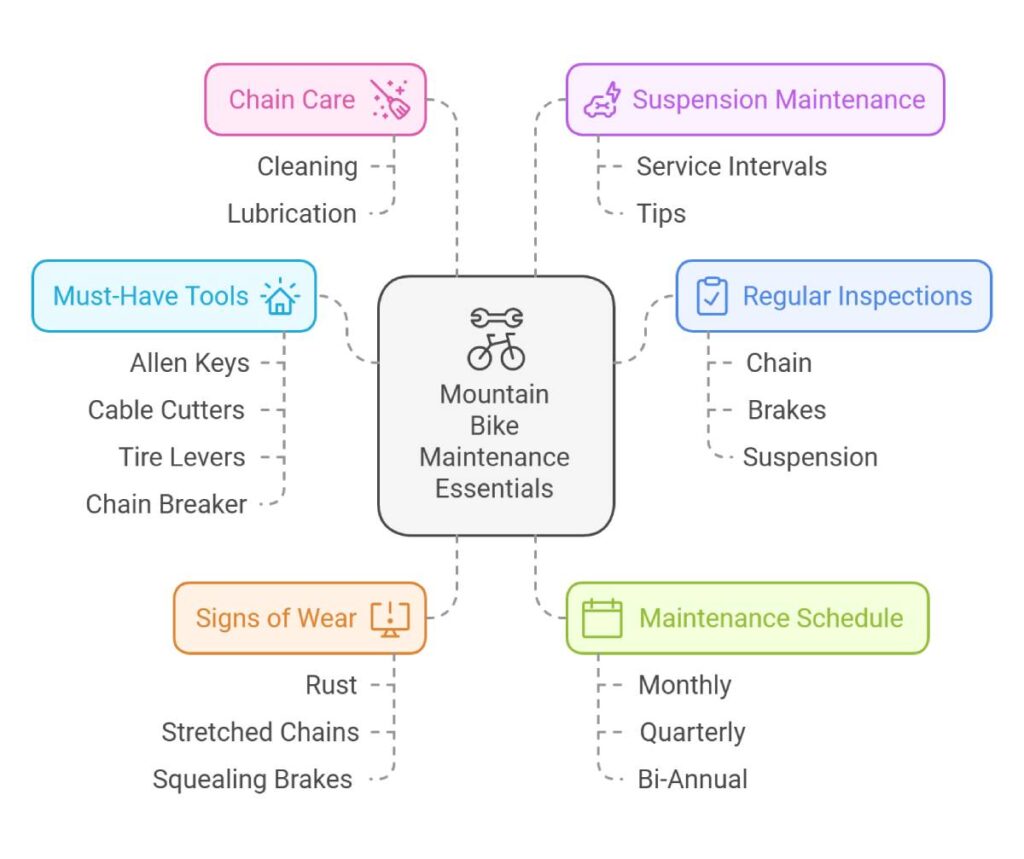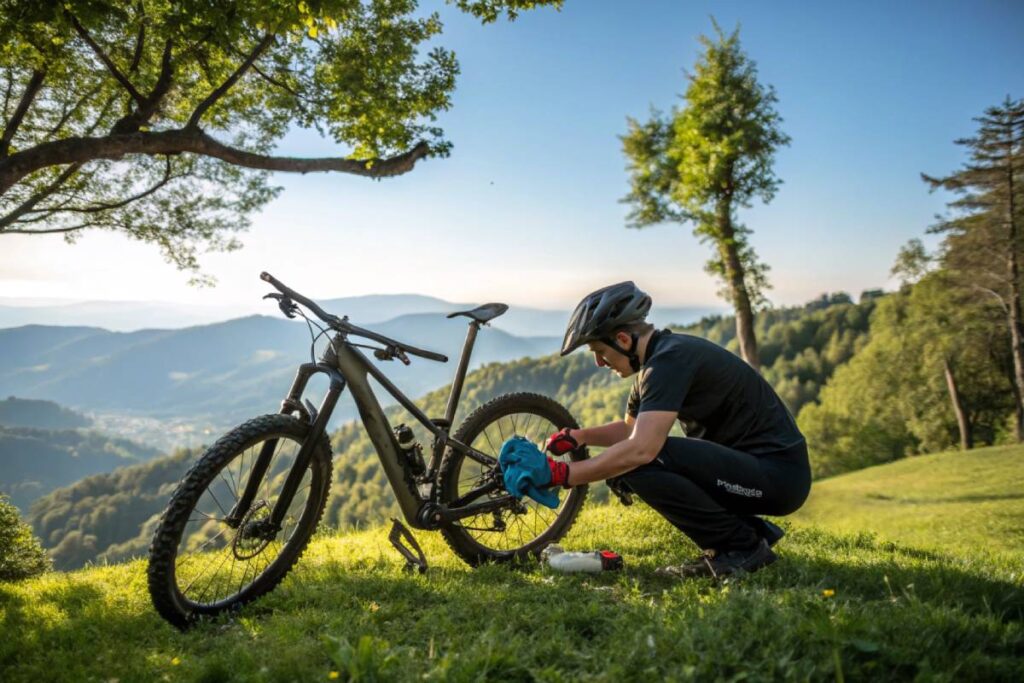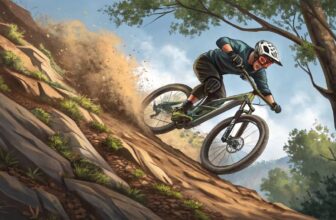Embarking on thrilling mountain bike adventures requires more than just grit and determination—it demands a well-maintained machine.
Imagine conquering rugged trails without the worry of unexpected breakdowns; that’s the power of proper bike maintenance. Whether you’re a seasoned enthusiast or just hitting the trails, mastering maintenance essentials ensures every ride is smooth and exhilarating.
From keeping your chain gleaming to fine-tuning your suspension, this guide dives deep into the must-know tips and tools that keep your mountain bike in peak condition. Ready to elevate your biking experience? Let’s gear up and ride ready!
Essential Mountain Bike Maintenance
Taking care of your mountain bike is like taking care of your favorite shoes; it keeps them working well and looking good. In this section, we’re diving into two big things: keeping your chain lubed and making sure your forks and suspension don’t give up on you!
Importance of Chain Lubrication
Your bike chain is the workhorse that keeps your wheels turning. Grease it up right, and you’ve got a smooth ride. Ignore it, and you’ll be surprised by some annoying squeaks and maybe even a rusty chain. Keeping it clean and lubed not only saves you a lot of future headaches but also keeps your bike running like a champ. Who wants to push a rusty chain up a hill anyway?
Every 100 to 150 miles, or when it starts looking grimy, give your chain a good clean and lube. Got a squeaky noise creeping in? That’s a big hint it’s thirsty for some oil. Keeping your chain happy means your rides will be smooth and stress-free.
| Chain Lubrication Task | Recommended Frequency |
|---|---|
| Clean & Lube Chain | Every 100-150 miles or when dirty |
| Check for Wear | Every ride |
If you’re wondering how to do this like a pro, swing by our mtb chain maintenance page.
Fork and Suspension Maintenance
If your chain is the heart of your bike, then the suspension is the soul. It’s what lets you glide over trails instead of feeling every bump and rock. But, this magic stops working if you don’t give it some TLC now and then.
For Fox forks, aim for a lower leg service every 30 hours of trail time. RockShox and Ohlins folks can stretch it to every 50 hours. A full service, which digs deeper into the nitty-gritty parts, should be done every 50 to 100 hours. Otherwise, you’ll start feeling like you’re riding a pogo stick instead of a mountain bike.
| Suspension Maintenance Task | Recommended Frequency |
|---|---|
| Lower Leg Service (Fox) | Every 30 hours |
| Lower Leg Service (RockShox, Ohlins) | Every 50 hours |
| Full Fork Service (Manitou) | Every 50-100 hours |
To keep things rolling smoothly, check your fork and rear shock pressure once a month. An annual suspension overhaul and a good overall bike tune-up will also keep your bike trail-ready and save you from painful breakdowns.
- Our mtb fork maintenance guide covers more on how to keep those forks in shape.
- Check out our muddy suspension setup tips too.
Stay ahead of the game with good bike maintenance habits, and your trusty two-wheeler will keep delivering those epic rides without the drama of sudden failures. A well-maintained bike is your key to carefree adventures on any trail.

Must-Have Bike Tools
If you’re diving into mountain bike maintenance, having your toolkit packed with essentials is key. Here’s a rundown of the must-haves every mountain bike enthusiast needs for smooth sailing.
Allen Keys for Adjustments
You’ve got your bike, now let’s get adjustin’! Allen keys, ranging from 2mm to 8mm, are the go-to for all those little tweaks (MBR). Whether you’re dialing in your brake levers or securing those crank bolts, a set of Allen keys keeps things tight and tidy.
| Allen Key Size | Common Uses |
|---|---|
| 2mm – 2.5mm | Tuning derailleurs |
| 3mm – 4mm | Tweaking brake lever reach and shifter clamp |
| 5mm – 6mm | Clamping seat posts and stem bolts |
| 8mm | Tightening crank bolts |
Cable Cutters for Trimming
Need to snip those cables? Get yourself some quality cable cutters. They’re a must for cleanly trimming hoses and brake lines. Shimano’s SIS cutters are loved for their sharpness and long-lasting performance. A crisp cut means no fraying, ensuring gears and brakes move as slick as can be.

Pliers and Cutters for Various Tasks
For all the odds and ends, needle nose pliers and side cutters are your trusty sidekicks. Grip, adjust, snip, you name it—these tools can handle the job. Keep your zip ties cleanly cut and cables in line with these handy helpers.
| Tool Type | Common Uses |
|---|---|
| Needle Nose Pliers | Handling small bits, nudging cables into place |
| Side Cutters | Snipping zip ties, neatening cables |
Importance of Chain Tool
Don’t get stranded with chain troubles—pack a chain tool. This gadget’s essential for fitting your chain just right, even if you’re using those nifty Powerlinks. Proper length equals peak performance, trust us.
Dig deeper into chain care with MTB Chain Maintenance.
Shock Pump for Suspension Adjustment
For the perfect ride, a shock pump is your suspension’s best friend. It lets you match your suspension to the load, terrain, and weather, yielding a ride as smooth as a summer breeze. Pick one with a visible gauge, bonus if it’s digital for spot-on tweaks. Regular tuning means your bike’s suspension is always spot on, boosting ride quality and comfort.
Learn more about setting up the perfect suspension with MTB Suspension Setup.
Armed with these tools, your mountain bike will be trail-ready for whatever comes your way. For more DIY brilliance, hop over to DIY Mountain Bike Repairs.
Proper Mountain Bike Care
Regular Maintenance Practices
Keeping your mountain bike in tip-top shape ain’t rocket science—just a bit of regular TLC will go a long way. Your trusty two-wheeler deserves this loving attention:
- Cleaning: Give that frame, drivetrain, and all the little bits a good scrub regularly. Check our handy guide on how to clean mountain bike for the nitty-gritty.
- Lubrication: Your chain’s not gonna lube itself. Give those chains, derailleurs, and pivot spots a slick weekly or after each ride, especially if you’ve been kicking up dust.
- Inspection: Give it a once-over for any wobbly bolts, or worn bits, and make sure those tires are hugging the ground just right. If you’re playing around with tire pressure, our MTB tire pressure guide can help you dial it in.

Components Requiring Maintenance
Do you have some special parts on your bike? Yup, they need some care, too:
- Drivetrain: Get that chain, cassette, and chainrings all shiny and well-oiled so your gears change like butter. Peek at our mtb chain maintenance for pro tips.
- Brakes: Whether you’ve got discs or rims, check on ’em often. Our mountain bike brakes comparison helps you figure out what they need.
- Suspension: Keep those shocks happy and bouncy by following what the maker says to do. Our mtb suspension setup has you covered.
- Frame: Give those tubes a look and make sure they’re crack-free.
- Tires & Wheels: Make sure your tires are beefy and wheels are straight as an arrow—our how-to true MTB wheel will guide you.
Suspension Service Schedules
Just like you, your bike’s suspension needs some downtime and tender care after hours of fun. Here’s a cheat sheet for service intervals:
| Component | Service Frequency (Hours) |
|---|---|
| Fork (Lower Leg) | Every 50 hours |
| Rear Shock (Air Can) | Every 50 hours |
| Full Fork Service | Every 100 hours |
| Full Shock Service | Every 100 hours |
Got a different terrain assignment? Check the pressure with a shock pump—the bike will thank you later.
Professional Service Recommendations
You can handle a lot yourself, but every six months, it’s wise to let the pros do their thing and keep everything fine-tuned. This tune-up might include:
- Drivetrain tune-up
- Brake adjustment and bleed (have a look at bleed mtb brakes)
- Suspension inspection and adjustment (see mtb fork maintenance)
- Wheel truing
Go on, pamper your mountain steed with these regular check-ups. It’ll keep you safe and riding smoothly. For all you DIY fans, our diy mountain bike repairs guide’s got your back with some extra tips.
Signs for Maintenance
Keeping mountain bikes in tip-top shape means you gotta give ’em some tender loving care. Ignoring those nagging signs might land you in a pit with hefty repair bills. Here’s what to keep an eye on to keep your ride smooth and steady.
Detecting Wear and Tear
Mountain biking means your two-wheeler takes a beating. Stress from off-road treks leaves its mark! Here’s how you catch wear before it wreaks havoc:
- Chain: Is your chain stretching or looking rusty? A stretched chain makes changing gears a nightmare and even chews up the cassette. For the nitty-gritty on chain care, check our handy-dandy mtb chain maintenance guide.
- Cassette: Slipping gears on a worn cassette? Replace it if those teeth look gnawed off.
- Bottom Bracket: Feel any wobble or resistance down there? Time to swap those bearings.
- Suspension Linkage: Give it a jiggle. Any play means it’s service time.
| Component | Signs of Wear |
|---|---|
| Chain | Stretch, rust |
| Cassette | Worn teeth |
| Bottom Bracket | Wobbling, rough |
| Suspension Linkage | Wobbling, stiffness |
Need more on keeping things ship-shape? Swing by our piece on MTB fork maintenance.
Abnormal Sounds Check
Weird noises are like a bike’s SOS. Listen up and tackle them head-on:
- Creaking or Clicking: These sounds might mean something’s loose. Grab those Allen keys and tighten up.
- Grinding: Might be those bottom brackets or hub bearings. Swap ’em out and silence the grind.
- Squealing Brakes: That shriek you hear could be glazed pads or dirty rotors. Give the rotors a nice scrub and fit some fresh pads if needed. Peek at our brake adjustment guide for a step-by-step.
Don’t shrug off these sounds. Take action fast to dodge pricey repairs. Whether it’s you or a pro giving the bike a once-over, regular care ensures a smooth roll. For tips on fixing things up yourself, check out our DIY mountain bike repairs guide.
Introduction to Mountain Biking
Different Disciplines
Mountain biking isn’t just rolling down a hill; there’s a world of styles each bringing its own thrills and spills. Here’s a peek at the popular ones:
- Cross-Country (XC): Think lots of pedaling over all sorts of land, with a nice mix of ups and downs. The bikes? Light as a feather, and just enough suspension.
- Trail Riding: Kind of like a sampler platter of mountain biking, with a healthy helping of climbs and descends. The bikes handle a little of everything with medium suspension.
- Downhill (DH): It’s all about barreling down steep trails with rocky bits. Bikes are built tough and have serious suspension travel.
- Enduro: Mix the stamina of XC with the thrill of DH, and you’ve got enduro. These bikes tackle both climbs and descents like a champ.
- Freeride: Picture stunts, jumps, and all sorts of parkour-like action, whether in the wild or on constructed spots. Sturdy bikes with hefty suspension are a must.
Importance of Suspension Maintenance
Keeping your suspension in check is like regular check-ups at the dentist—important if you want to keep riding smooth, safe, and joyfully teeth-rattle-free. A reliable bike is a lifesaver, especially downhill! It’s smart to stay on top of maintenance, especially by giving the fork and shock a pressure check every month.
Skipping suspension care? That’s a bad move—one that could cost you big with hefty repairs later down the line. Experts say giving the suspension a once-over yearly and a pro tune-up is the best bet.
Types of Mountain Bikes
Mountain bikes, much like ice cream, come in different flavors to match every taste and need:
| Bike Type | Features | Best For |
|---|---|---|
| Full-Suspension | Bouncy suspension front and back | Great for mixed terrains |
| Hardtail | Only front suspension | XC and trails with the occasional bump |
| Fully Rigid | No bouncy bits at all | Nice smooth trails, maybe the ride to the store |
| Adaptive | Special tweaks for differently-abled folks | Making everyone’s trail dreams come alive |
Picking the right type? Full-suspension bikes are comfy and give you more control on bumpy trails. Hardtails are lighter, and great for climbing. Fully rigid bikes are simple and sweet for smoother paths.
Wheel Size Considerations
Choosing wheels might seem like fine print, but it actually makes a big difference in how comfy and easy your ride is. Here are the main players:
| Wheel Size | Benefits | Best For |
|---|---|---|
| 26″ | Light and nimble | Winding, tricky paths |
| 27.5″ (650B) | Perfect balance of control and ease | Good all-rounder |
| 29″ | Bulldozes over rough spots, keeps going strong | Long rides, rougher stuff |
Still can’t decide? Check out our deep dive on 27.5 vs 29er MTB to get more tips on picking your perfect wheels.
Getting a handle on the different biking types, staying up on maintenance, knowing your bike options, and choosing the right wheels can make riding way more enjoyable. Treat your suspension right, and it’ll return the favor by keeping you safe and extending your bike’s life. For more biking tips, see our mountain biking basics section.
Mountain Bike Gear Essentials
Mountain biking is a wild adventure, but to really enjoy it, the right gear is a must. Everything from safety to comfort will truly crank up your ride.
Safety Gear
Safety is a no-brainer when hitting the trails. This stuff keeps you from turning a fun day into, well, a not-so-fun day.
| Gear | What It Does |
|---|---|
| Helmet | Keeps your melon safe from bumps |
| Sunglasses/Goggles | Stops stuff from poking your eyes and cuts glare |
| Pads and Protection | Shields knees, elbows, and other boney bits |
| Gloves | Boosts grip and saves your palms when you take a tumble |
- Helmet: Your noggin needs a snug and solid helmet. Brands like Giro and Bell are top contenders if you wanna keep your brain in one piece. Check out our selection here.
- Sunglasses/Goggles: These bad boys fend off dirt, bugs, and sun rays. Oakley and Smith Optics make you look cool while doing it.
- Pads and Protection: If you’re gonna get gnarly, some sturdy knee and elbow pads are worth the investment. Browse some top picks from our knee pad guide.
- Gloves: Not just for warmth, full-finger gloves are great for grip and acting as a cushion when you hit the deck. Fox and Dakine are biker faves.
Stay smart and check out more safety smarts on our tips page.
Comfort Enhancing Gear
Comfort can easily make or break the joy of a long ride. The right gear will keep you from feeling like you were dragged behind your bike.
| Gear | Why You Need It |
|---|---|
| Shoes | Keeps feet cozy and stuck to the pedals |
| Chamois/Shorts | Stops the rub and cushions your butt |
| Jerseys | Keeps sweat away and lets you breathe |
| Pants | Shields legs from stuff the trail throws at you |
- Shoes: Specialized and Shimano have your kicks covered. Climb harder and longer with grippy, cushy mountain bike shoes for flat pedals. Check our picks here.
- Chamois/Shorts: A padded seat can be your best friend after an all-day ride—try out Pearl Izumi for biking shorts that keep the pain at bay.
- Jerseys: Say goodbye to the sweat-soaked nightmare with jerseys from Endura and Troy Lee Designs.
- Pants: Stay protected with pants that can handle the elements. Fox and Alpinestars have reliable gear for rough rides.
Need more on comfy outfits? Head over to our style guide.
Getting the right gear in your kit is a game-changer on the trail. Whether you’re making your first purchase, have some miles under your belt, or go hard as a pro, having quality gear is everything. Just remember to keep both your bike and gear in top shape. Check out our maintenance tips here.
Brake Adjustment Guide
Mountain bike brakes are vital for safety and command, especially when tackling tricky trails. Let’s break down how to fine-tune those disc brakes so they’re performing at their best.
Why Disc Brakes Matter
Disc brakes reign supreme for stopping power, especially when it’s rainy or muddy out there. Having them fine-tuned isn’t just for show; it’s about ensuring your bike stops when you want it to, be it during an epic ride or a quick jaunt.
Take a brand like Huffy. They sometimes use materials like stamped sheet metal for their brake bits. Nothing wrong with meeting baseline safety, but these can mess with how well the brakes work.
Tweaking the Rotor and Pads
Keeping your brake rotor and pads in check is a must for smooth stops. Follow these quick steps:
- Rotor Alignment: Get that rotor lined up right between the brake pads. Spin the tire and listen up for any rubbing—that means you’ve got a little adjustment to do.
- Caliper Fine-tuning: Loosen those caliper bolts, squeeze the brake lever to center the rotor, then tighten them back up.
- Pad Spacing: Eye the pad distance from the rotor. They should be equally spaced to dodge uneven tears.
Lever Magic: Reach and Contact Point
Dialing in the lever reach and contact point can make the ride a whole lot smoother.
- Adjusting Lever Reach: Most of today’s disc brakes have a dial by the lever. Twist it to bring the lever where it feels right for your mitts.
- Contact Point Setup: This is where the pads hit the rotor. Fiddling with it can take your braking finesse up a notch.
| Adjustment | Why It Matters |
|---|---|
| Lever Reach | Makes grabbing the brakes comfortable and easy |
| Contact Point | Ensures your braking is on point |
Need more tricks? Check out our piece on mtb braking techniques.
Glazed Brake Pads and What They Mean
When brake pads get glazed, your stopping game weakens. Look out for these signs:
- Squealing or squeaks when you brake
- Braking feels wimpy
- Pads that look shiny or overly smooth
Keep an eye on those brake pads, and swap them out if they’re glazed, so your stops stay sharp.
For maintenance tips and when to get a service, swing over to our mountain bike maintenance page.
Bike-Specific Maintenance Tips
Adjustments for Specific Bike Models
Different mountain bike models aren’t just cookie-cutter frames on wheels. Take Huffy models, for example. Their brake arms, often forged from thin metal, can bend when you squeeze the brake lever. This bending can make stopping feel like trying to halt a speeding bullet with a feather (source).
Regularly giving these brake arms a once-over will help make sure they’re doing their job—helping you stop before a tree does it for you.
Chains are the next big thing—they’re not just there to dirty your hands. Some bike models have fancy drivetrain setups that need precise chain tension. Keeping it tight—but not too tight—means less frustration and more smooth gear changes. If the chains have you puzzled, we break it all down in our guide on mtb chain maintenance.
Wheel and Rim Maintenance Guidelines
Your mountain bike isn’t much without its wheels, and they’re a bit needy. Keeping an eye on the rims is essential—it’s like the difference between gliding down the trail and bouncing like a basketball.
Make sure there’s a nice space between brake pads and rim, so your wheel can spin without feeling the brakes’ unwanted affection. And don’t forget even brake pressure which stops you from veering off your intended path while stopping.
Got a rim that’s wobbly like grandma’s jello? Trimming and straightening that bend can make all the difference. Check out our piece on how to true the mtb wheel. A little attention to those spokes and hub lubrication is like a spa day for your bike—keeps everything feeling good and running like clockwork.
| Component | Maintenance Action | Frequency |
|---|---|---|
| Rims | Check for damage, true if necessary | Monthly |
| Spokes | Tighten to maintain balance | Monthly |
| Hubs | Lubricate and check for play | Quarterly |
Importance of Periodic Tune-Ups
Tune-ups may sound boring, but they’re your bike’s best friend. If you’re a weekend warrior, riding about once a week, pencil in a full service every 6 months. These check-ups include brakes, drivetrain, suspension, and wheel alignment—basically a full health check.
Catching little problems before they turn into big troubles lets you spend more time biking and less time cursing on the side of the trail. Regular servicing keeps everything from brakes to chains working in harmony, extending the life of your parts and making sure your bike gives you a smooth ride from top to bottom. Check more deets on consistent care in our guide on proper mountain bike care.
| Tune-Up Task | Importance | Recommended Frequency |
|---|---|---|
| Brake Check | Ensures safety and responsiveness | Every 6 months |
| Drivetrain Inspection | Prevents chain and gear issues | Every 6 months |
| Suspension Service | Enhances ride comfort and control | Every 12 months |
| Wheel Alignment | Keeps wheels in balance | Every 6 months |
If you’re the hands-on type, our article on DIY mountain bike repairs is your trusty toolkit in print. By using these bike-specific tips, you’ll ensure your mountain bike runs like a dream and is always ready for the wild trails ahead.
Conclusion
Maintaining your mountain bike is the cornerstone of every successful ride. By diligently lubricating your chain and keeping your suspension in top shape, you ensure that your bike remains responsive and reliable on any trail.
Equipping yourself with the right tools, such as Allen keys and shock pumps, empowers you to perform essential tweaks and fixes with confidence. Regular cleaning, thorough inspections, and timely maintenance not only prolong the lifespan of your bike but also enhance your riding performance and safety.
Recognizing the signs of wear and addressing them promptly can save you from unexpected breakdowns and costly repairs. Additionally, understanding the specific needs of your bike model and adhering to professional service schedules further solidifies your bike’s health.
Whether you’re navigating rugged terrains or enjoying smooth trails, a well-maintained mountain bike is your ticket to countless exhilarating adventures. Embrace these maintenance practices, and your bike will faithfully accompany you on every thrilling journey, ensuring that each ride is as enjoyable and stress-free as the last.
Remember, a little effort goes a long way in keeping your mountain biking passion alive and thriving.
FAQs
What is the best frequency for chain lubrication on a mountain bike?
Chain lubrication should be performed every 100-150 miles or whenever the chain appears dirty. Regular cleaning and lubing ensure smooth gear shifts and prevent rust.
How often should I service my mountain bike’s suspension?
For Fox forks, perform a lower leg service every 30 hours of trail time. RockShox and Ohlins forks can be serviced every 50 hours. A full suspension service should be done every 50-100 hours depending on usage.
What tools are essential for mountain bike maintenance?
Essential tools include a set of Allen keys, cable cutters, needle nose pliers, a chain tool, and a shock pump. These tools help with adjustments, cable trimming, chain maintenance, and suspension tuning.
How can I detect wear and tear on my mountain bike?
Regularly inspect your chain for rust or stretching, check the cassette for worn teeth, feel for wobbling in the bottom bracket, and ensure suspension linkages are tight. Abnormal sounds like creaking or grinding also indicate wear.
When should I seek professional help for my bike maintenance?
While basic maintenance can be done at home, it’s advisable to have a professional tune-up every six months. Professionals can handle complex tasks like drivetrain tune-ups, brake adjustments, suspension inspections, and wheel truing.
Final Thoughts
Maintaining your mountain bike is not just a chore—it’s an investment in countless unforgettable rides and adventures. By following the essential maintenance practices outlined in this guide, you ensure that your bike remains reliable, efficient, and ready to tackle any trail.
From the vital task of chain lubrication to the intricate care of your suspension system, each step plays a crucial role in enhancing your biking experience.
Equipping yourself with the right tools and understanding the signs of wear can save you time, money, and frustration in the long run. Moreover, prioritizing regular inspections and professional tune-ups keeps your bike performing at its best, allowing you to focus on what truly matters: the thrill of the ride.
Embrace these maintenance habits, and your mountain bike will be your steadfast companion, delivering smooth and exhilarating journeys wherever your passion takes you.
Remember, a well-maintained bike is the key to unlocking endless trails and making every ride a joyous adventure.
Key Tips
- Regularly Clean and Lubricate Your Chain: Prevent rust and ensure smooth gear shifts by maintaining your chain every 100-150 miles.
- Schedule Suspension Maintenance: Adhere to service intervals specific to your suspension brand to maintain optimal performance.
- Invest in Quality Tools: A well-equipped toolkit makes DIY maintenance easier and more effective.
- Perform Routine Inspections: Check for wear and tear, and address any issues promptly to avoid bigger problems.
- Prioritize Safety Gear: Always wear a helmet, gloves, and protective pads to ensure a safe and enjoyable ride.
- Understand Your Bike Type: Choose maintenance practices tailored to whether you have a full-suspension, hardtail, or rigid bike.
- Seek Professional Tune-Ups: Regular professional servicing can catch issues you might overlook and keep your bike in top condition.
Recommended Biking Products and Accessories
- Bike Lubricants:
- Finish Line Dry Teflon Lubricant: Ideal for chain maintenance in dry conditions.
- Park Tool CL-4 Lubricant: Versatile for various biking conditions.
- Suspension Tools:
- RockShox Service Kit: Comprehensive kit for RockShox suspension maintenance.
- Fox Performance Suspension Service Kit: Essential for Fox fork upkeep.
- Toolkits:
- Topeak Mini Toolbox: Compact and includes essential Allen keys and tools.
- Park Tool MT-10.2: Multi-tool with a wide range of functions.
- Brake Components:
- Shimano Deore Brake Pads: Reliable and high-performance brake pads.
- SRAM Level T4 Rotor: Durable and precise braking performance.
- Safety Gear:
- Giro Helmet: Lightweight and offers excellent protection.
- Oakley Radar EV Path Goggles: Clear vision and robust design.
- Fox Racing Knee Pads: High-quality protection for rough trails.
- Comfort Gear:
- Specialized Mountain Bike Shoes: Durable and comfortable for long rides.
- Pearl Izumi P.R.O Shorts: Padded for maximum comfort.
- Endura Mizzn Long Sleeve Jersey: Breathable and moisture-wicking.
- Maintenance Tools:
- Park Tool Chain Tool: Essential for chain adjustments and repairs.
- SKS Shock Pump: Accurate suspension pressure adjustments.
- Storage and Transport:
- Dakine Bike Sack: Protects your bike during transport.
- Topeak Modular Bike Tool Kit: Organized storage for all your maintenance tools.
Investing in these products ensures that you have everything needed to keep your mountain bike in pristine condition, enhancing both performance and longevity.




